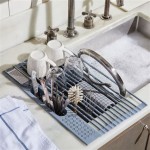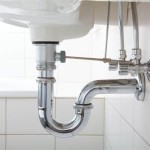```html
28 x 16 Undermount Kitchen Sink: A Comprehensive Guide
The 28 x 16 undermount kitchen sink represents a versatile and practical choice for many homeowners. Its dimensions offer a balance between accommodating larger cookware and fitting comfortably within standard kitchen cabinet sizes. This article provides a detailed exploration of the 28 x 16 undermount kitchen sink, examining its benefits, material options, installation considerations, and maintenance requirements.
An undermount sink is installed beneath the countertop, creating a seamless transition from the work surface to the sink basin. This installation style is characterized by a clean aesthetic and ease of cleaning. Debris can be easily swept directly from the countertop into the sink without obstruction, enhancing hygiene and efficiency in the kitchen.
Benefits of a 28 x 16 Undermount Kitchen Sink
The 28 x 16 undermount kitchen sink offers several compelling advantages that contribute to its popularity among homeowners and kitchen designers. These benefits encompass both functional and aesthetic considerations.
Firstly, the size of the sink (28 x 16 inches) offers a substantial basin area without overwhelming the countertop space. This is especially useful for washing large pots, pans, and baking sheets. The depth of the sink, which typically falls between 8 and 10 inches, further enhances its utility for handling larger items and minimizing water splashing.
Secondly, the undermount installation creates a smooth, uninterrupted countertop surface. This minimalist design is visually appealing and complements a variety of kitchen styles, from modern and contemporary to traditional and farmhouse. The absence of a visible rim around the sink facilitates easy cleaning, preventing the accumulation of dirt and grime.
Thirdly, undermount sinks often provide better support for the countertop material. With the sink securely attached to the underside of the countertop, the structure is inherently stronger compared to top-mount sinks, which rely on the countertop for primary support. This can be particularly important for heavier countertop materials like granite or quartz.
Fourthly, the undermount design allows for greater flexibility in countertop material selection. The sink's hidden mounting eliminates the need to match the sink's edge to the countertop's edge. This provides a broader range of design options, allowing homeowners to choose the best material based on their aesthetic preferences, budget, and durability requirements.
Material Options for 28 x 16 Undermount Kitchen Sinks
The 28 x 16 undermount kitchen sink is available in a wide array of materials, each possessing distinct characteristics in terms of durability, aesthetics, and price. Selecting the appropriate material is crucial for ensuring the sink meets the homeowner's specific needs and preferences.
Stainless Steel: Stainless steel is a highly popular choice for kitchen sinks due to its durability, resistance to staining and corrosion, and affordability. It is also relatively lightweight and easy to clean. Stainless steel sinks are graded by gauge, with lower numbers indicating thicker steel. A gauge of 16 or 18 is generally recommended for a durable and relatively quiet sink. Some stainless steel sinks feature sound-dampening pads to further minimize noise during use.
Granite Composite: Granite composite sinks are made from a mixture of granite stone dust and acrylic resins. This material is exceptionally durable, resistant to scratches, heat, and stains. Granite composite sinks are available in a variety of colors, allowing for seamless integration with different countertop and cabinet finishes. They are typically more expensive than stainless steel but offer a more luxurious look and feel.
Fireclay: Fireclay sinks are crafted from clay fired at extremely high temperatures, resulting in a dense, non-porous material. They are known for their durability, resistance to staining, and classic aesthetic. Fireclay sinks are typically heavier and more expensive than stainless steel or granite composite options. They are particularly well-suited for farmhouse-style kitchens.
Cast Iron: Cast iron sinks are made from iron coated with a layer of enamel. They are incredibly durable and known for their heat retention properties. Cast iron sinks are available in a variety of colors and finishes, including glossy and matte options. However, they are very heavy and require strong cabinet support. The enamel coating can also be susceptible to chipping or scratching under heavy use.
Copper: Copper sinks offer a unique and antimicrobial aesthetic. They develop a natural patina over time, adding character and visual interest to the kitchen. Copper sinks are relatively soft and can be prone to scratching or denting. They require specialized cleaning products to maintain their appearance. Copper sinks are generally more expensive than stainless steel or granite composite sinks.
Installation and Maintenance Considerations
Proper installation is essential for ensuring the longevity and performance of a 28 x 16 undermount kitchen sink. Professional installation is generally recommended, especially for heavier sink materials or complex countertop installations.
Before installation, it is crucial to ensure the countertop is properly prepared and reinforced to support the weight of the sink and any items placed within it. The sink is typically attached to the underside of the countertop using clips and epoxy adhesive. The plumbing connections must be carefully sealed to prevent leaks.
Maintaining a 28 x 16 undermount kitchen sink is relatively straightforward. Regular cleaning with mild soap and water is typically sufficient to remove dirt and grime. Abrasive cleaners should be avoided, as they can scratch or damage certain sink materials.
For stainless steel sinks, a specialized stainless steel cleaner can be used to remove water spots and maintain shine. Granite composite sinks can be cleaned with a non-abrasive scrub brush and a mild detergent. Fireclay sinks should be cleaned with a gentle cleanser and a soft cloth to prevent scratching.
For copper sinks, specialized copper cleaners are available to help maintain their patina and prevent tarnishing. Regular waxing can also help to protect the surface of the copper.
Regardless of the sink material, it is important to avoid leaving standing water in the sink, as this can lead to the formation of water spots or mineral buildup. Regularly rinsing and drying the sink after each use will help to maintain its appearance and prevent the accumulation of residue.
Furthermore, it is advisable to use a sink grid to protect the bottom of the sink from scratches and dents. Sink grids also help to prevent dishes from sitting directly on the sink surface, which can improve drainage and hygiene.
```
Premium 16 Gauge Stainless Steel Single Bowl Kitchen Sink Kraus

28 X 16 Inch Undermount Kitchen Sink 304 Stainless Steel Double Bowl Workstation Sinks Portable Hand Made In China Com

Ruvati 28 Inch Workstation Ledge Undermount 16 Gauge Stainless Steel Kitchen Sink Single Bowl Rvh8309 Usa

Premium 16 Gauge Stainless Steel Single Bowl Kitchen Sink Kraus

28 Undermount Workstation Sink With Stainless Accessories

Ruvati 28 Inch Undermount Kitchen Sink 50 Double Bowl 16 Gauge Stainless Steel Rvm5077 Usa

Kraus Standart Pro Undermount 28 In X 19 Stainless Steel Single Bowl Kitchen Sink Khu100 At Com

Nantucket Sinks Undermount 28 In X 16 Satin Stainless Steel Single Bowl Kitchen Sink At Com

27 Undermount Stainless Steel Single Bowl Kitchen Sink Ksn 2718 9 S

28 Undermount Workstation Sink With Stainless Accessories







